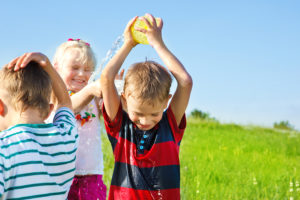We hear plenty of questions about caring for your new bundle of joy at Mary Margaret’s Day Care. Here’s some advice as you get to know the newest member of your family. Yes, these first few weeks can be tough. But they’re worth it.
Bathing and Grooming Your Newborn
Let’s start with the umbilical cord. Whenever you change your baby’s diaper, gently wipe his tummy, but try to keep the cord dry. Don’t tuck it inside your baby’s diaper; this could trap moisture or make the area irritated.
For new parents concerned about bathing their new baby, an occasional sponge back is really all your baby needs during the first month. Wash your baby with a soft cloth and some warm water. You can use gentle, unscented soap if you need to, but don’t use too much. After that first month, you can begin giving your baby immersive baths – one to three times per week. You can also use a baby-friendly lotion regularly to keep your baby’s skin hydrated and perfectly soft.
Are you alarmed about blemishes on your baby’s skin? Don’t be. It’s very common for newborns to develop little baby acne on their nose, forehead, or chin. These are hormone-related, and they’ll go away on their own within a couple of weeks. If your baby develops a rash that just won’t go away, then it’s probably time to contact your pediatrician.
Remember to always handle your baby gently, and be mindful of soft spots on your infant’s head. The skin on your baby’s scalp is delicate, too, so avoid scrubbing too hard if you use shampoo on your baby’s hair. A gentle massage with unscented shampoo designed for babies is all your infant needs a couple of times per week. Be sure to use a brush with extra-soft bristles if you need to detangle your baby’s hair.
Until your baby learns how to control his hands, it’s helpful to trim his fingernails and toenails. This will keep your baby from scratching himself. Don’t use adult-sized clippers, which can hurt your baby. In fact, you can usually round out edges with a baby nail file. Baby clippers are okay to use, too, but do not bite your baby’s nails! This can spread bacteria.
Feeding Your New Baby
Many new moms worry about feeding their newborn. Fortunately, your baby will let you know, loud and clear, when she’s hungry and when she’s had enough.
Generally, new infants need to be fed every two to three hours. During the first six weeks, doctors recommend that you let your baby nurse whenever she wants. If you’re breastfeeding, you shouldn’t try to establish a feeding schedule too early because it might interfere with your milk supply. If you’ve chosen to use formula, here are some tips to make feeding easier:
- Heat the formula in a bottle warmer or a pan of warm water. Don’t microwave! It can create dangerous hot spots that can harm your baby.
- Use room-temperature formula within two to four hours. If the formula has been sitting around, discard it. You can use refrigerated formula within 48 hours.
- If your baby leaves formula behind in the bottle, don’t save it. It can hold bacteria from your baby’s saliva.
- Don’t freeze formula; that can rob it of its nutritional value.
What About Sleep? And What About the Crying?!
There’s no way to sugarcoat it: the first three months are going to be tough. Your baby needs to eat every two or three hours, so any kind of regular sleep schedule may feel like a unreachable dream. Don’t worry. You’ll get there. By three months, most babies can sleep for six to eight hours. While you’re waiting for that blessed day, try the best you can to get your child on a day and night schedule. That means not letting him sleep more than three hours before waking him up during the daytime. At night, let him sleep a little longer.
Even if you can’t get your baby on a sleep schedule right away, try to be consistent when it comes to sleep time. Experts suggest winding-down activities like baths, lullabies, rocking, or saying prayers. If you develop a routine in which you do the same activities in a predictable order, your baby will anticipate what comes next. You’ll make sleep time a little easier on baby and on yourself.
What about letting your baby “cry it out?” Some mothers swear by it; others find it appalling. The truth is, it’s okay to let your child cry a bit at night. Notice we say “a bit.” We don’t mean letting your baby cry for hours. Childcare experts argue that teaching babies how to “self-soothe” or calm themselves down is actually better for them in the long run.
Here’s something we don’t have to remind you: babies are going to cry. That sometimes piercing sound lets you know when they’re cold or hungry or need to be changed. Yes, it’s frustrating, but as your baby grows, you’ll begin to intuitively know what she needs. If you’re at your wit’s end, try a few of these tips:
- Check to see if your baby’s clothing is too tight, if her diaper is soiled, or if she’s too hot or cold.
- Let your baby suck on a bottle or pacifier. This helps to soothe a fussy baby.
- Swaddle your child tightly in a blanket or hold him snugly while rocking him. Often, if you can recreate a womb-like environment, your child will calm down.
- Babies respond well to gentle motions. Try rocking, walking, or taking your child for a stroller ride. If all else fails, put your child in an infant swing and take a break.
- Try to remember that babies just cry sometimes. It will pass. If you can manage to keep yourself calm and relaxed, your baby will eventually feel that way, too.
When to Call the Doctor
When is it an emergency? We advise parents to always call a pediatrician if your baby shows any of the following signs:
- Has a high fever. For babies younger than 2 months, any fever over 100 degrees F should be reported to a doctor right away.
- Is excessively lethargic or unresponsive.
- Displays sudden changes in eating patterns, such as refusing to nurse.
- Has very watery stools. Or, has a distended abdomen, strains when moving his bowels, or vomits rather than just spitting up.
- Has a red, swollen rash.
- Is excessively fussy or cries inconsolably for longer than usual.
Call the Nurturing Staff at Mary Margaret’s if You Need Reliable Care
Again, these first few weeks can be tough, but you don’t have to do it all yourself. If you’re looking for compassionate, reliable care for your new baby, call the staff at Mary Margaret’s. We can give you some time off, and some peace of mind, too.









